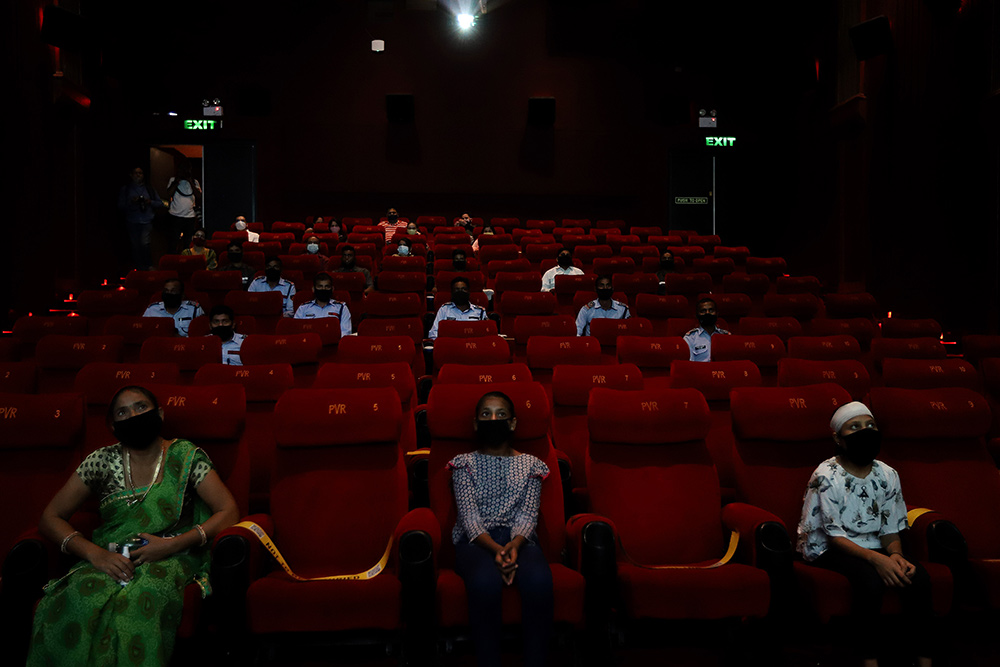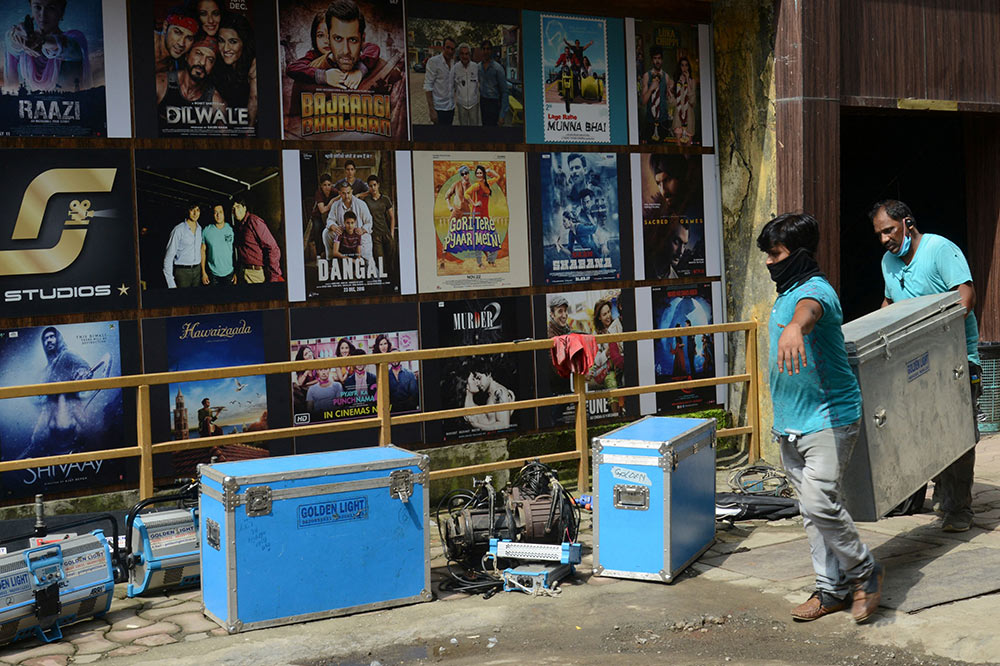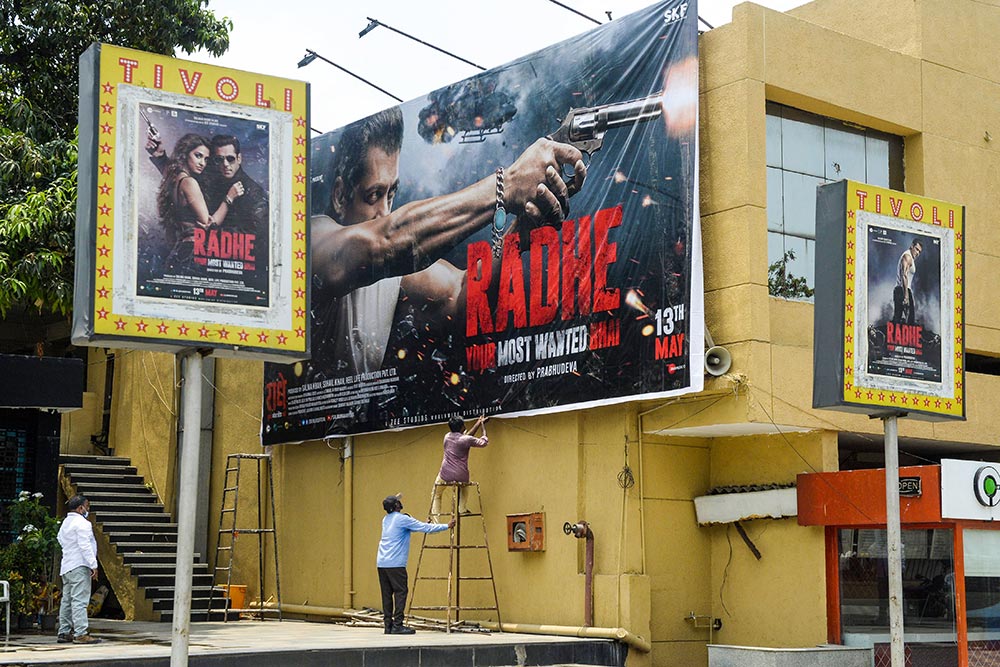位于印度孟买的宝莱坞(Bollywood)代表着价值25亿美元的印地语电影产业。一部大型宝莱坞制片厂电影的成功,在很大程度上取决于影院的观众,因为他们贡献了电影的大部分收入。影迷表示,宝莱坞出品的歌舞片时长一般在三小时左右,最适合的观影方式是集体观看——在电影院里与其他观众一起歌唱、欢笑、鼓掌或者哭泣。
小说《孟买:欲望丛林》(Maximum City: Bombay Lost and Found)的作者苏科图·梅塔为《纽约时报》(New York Times)撰写了一篇文章,讲述了他对于去影院观看宝莱坞电影这种体验的热爱。“我为什么喜欢宝莱坞电影?对一个印度人来说,这就像问我们为什么爱自己的母亲;我们别无选择。我们可以直接跟银幕上的人物对话、拍手、吹口哨或者发出嘲笑,特别高兴的时候,还能够扔硬币来表示对电影的喜爱。”印度的电影院与世界其他地方不同,因为其他大多数影院都要求观众尽量保持安静。
受新冠肺炎疫情的影响,印度各地的电影院纷纷停业,电影制作也不得不暂停。影迷们被迫留在家中,转而通过网络进行娱乐消费。PVR Pictures旗下有着印度最大的连锁院线。该集团的首席执行官卡迈勒·吉安昌尼表示,2020年,印度院线的收入骤降至3.77亿美元,相比2019年的19亿美元下降了80%。
过去的18个月引发了一场辩论——印度的电影和观众是否会重返院线,宝莱坞的未来是否会被降级到个人设备上等等。新德里Diorama国际电影节(Diorama Film Festival)的联合创始人、电影及广告制作公司India Shoots的创始人库纳尔·斯里瓦斯塔瓦指出,大多数行业分析师都希望观众可以回归影院,因为传统的宝莱坞观影体验“不可能在手机或家庭电视屏幕上实现”。
同时,该行业也无法阻止新数字消费趋势的发展。Viacom18 Studios的首席运营官阿吉特·安德黑尔认为,数字消费趋势“将继续存在并不断发展”,意味着宝莱坞将不得不同时拥抱大银幕和小屏幕。
宝莱坞对抗新冠肺炎疫情
对宝莱坞来说,2020年是艰难的一年。电影院在这一年的大部分时间里都是关闭的。2020年的首部宝莱坞影片《塔纳吉:无名勇士》(Tanhaji: The Unsung Warrior)于1月在影院首映,取得了5200万美元的票房收入,也是2020年的票房冠军——这一年在影院上映的电影数量很少。2019年的宝莱坞电影票房冠军是Yash Raj Films出品的动作片《宝莱坞双雄之战》(War)。该片由巨星赫里尼克·罗斯汉领衔主演,总票房达6700万美元。2020年3月,印度政府针对疫情实施了为期两个月的全国性封锁措施。但此后,电影院又继续停业达六个月的时间。政府首先放松了对基本服务的限制;影院复工则是次要事项。

疫情关停了电影的拍摄制作,更打击了该行业的盈利能力。阿莉雅·布哈特、迪皮卡·帕度柯妮和卡特莉娜·卡芙等最具商业价值的明星均感染了新冠肺炎(并已经康复)。片场的技术人员、化妆师、背景舞者和初级演员等日薪制工作人员受到的影响最为严重。由于政府未能提供相关援助,Netflix等公司以及萨尔曼·汗等明星均承诺要为该群体提供资金支持。
2020年全年,宝莱坞只发行了441部电影,而其2019年的发行量达1833部。同时,宝莱坞2020年影院观众的数量下降了73%,仅为3900万,前一年则为14.6亿。咨询公司安永(EY)的报告《2020年印度媒体和娱乐》(India 2020 Media and Entertainment)指出,多达1500家单银幕影院(每次只放映一部电影的影院)已经永久停业,印度全国仅余8000块大银幕。多厅影院也遭受了重创,但转向其他业务(比如举办私人放映或现场活动,以及实施扫描二维码订购食品等新措施)对此类影院来说则更加容易。
罗伊·卡普尔电影公司(Roy Kapur Films)的创始人、印度制片人协会(Producers Guild of India)的主席悉达斯·罗伊·卡普尔称:“很多(规模较小的)单银幕电影院没有大公司的资助,不得不停业或出售给大型企业。这是一个零和游戏,因为你要么开放,要么不开放。”他说,很多单银幕影院都倒闭了,无力负担租金、维护费用和工人工资。
随着第一波疫情的消退,印度政府在去年10月给电影院开了绿灯,但只允许50%的上座率。斯里瓦斯塔瓦表示,第一轮封锁结束后,印度有“大量的观众重返影院”。这种反弹也唤起了电影行业的信心,坚信观众会回到影院观影。

转向流媒体平台
电影院长达数月的停业,让消费者转向了在线娱乐。Viacom18 Studios的安德黑尔指出:“对流媒体来说,这场疫情无疑是一个‘黑天鹅事件’,流媒体的业务量出现了大幅增长。”
印度现在共有约4000万用户订阅了一个或多个流媒体平台,这一数据自疫情开始以来增长了40%。(这还不包括那些通过流量捆绑套餐获取内容订阅服务的消费者,该群体约有2.5亿人。)安永的媒体和娱乐合伙人阿希什·菲尔瓦尼表示,这类消费群体的用户数量足以同每年去影院观看电影的1亿人次相提并论。
失去院线收入的电影制作公司,可以通过向电视和流媒体平台(例如迪士尼+ Hotstar、亚马逊和Netflix)出售内容来挽回一些收入。前文中提到的安永的报告指出,宝莱坞电影制作公司2020年的数字版权收入翻了一番,达4.718亿美元。电影贸易分析师、宝莱坞电影杂志《电影信息》(Film Information)的主编科马尔·纳塔表示,制作公司“在过去18个月里绕过院线来发行电影,(直接)将大约30至40部影片出售给了流媒体平台。这是变现其投资的唯一途径。”
大型制片厂索尼影业印度公司(Sony Pictures India)也实现了向流媒体的跨越。该公司于2020年7月在亚马逊Prime Video上线了剧情片《左右互搏》(Gulabo Sitabo)。宝莱坞偶像阿米特巴·巴强在本片中扮演了一位吝啬的老房东。索尼影业印度电影公司的常务董事维韦克·克里希纳尼称,公司还将《拨号100》(Dial 100)的版权卖给了印度流媒体平台Zee 5,并计划于9月初在另一个平台上线电影《头盔》(Helmet)。
在疫情之前,这种发行策略对大多数大型电影公司来说都是无法想象的。那时,大型电影公司会首先进行院线发行,等影片在院线放映约8到10周后,再将数字版权卖给网络平台。纳塔表示,即便电影公司会随着疫情的缓解而恢复院线首映,它们仍然可能加快电影在网络平台上发行的速度,也许在首映后6周内就会进行数字发行。
业内专家表示,大制片厂通过数字发行挽回了部分损失,但从长远来看,中小型制片厂更有可能从流媒体的繁荣中受益。安德黑尔说,许多“中小成本的电影会在这些平台上得到更多的关注”。因为在院线,这类影片通常会被大制作电影的巨额预算和明星效应所掩盖。此外,数字平台的营销和广告花费相对较少,这对小型电影公司来说是一项额外的优势。
观众对数字内容的需求只会越来越大。Netflix于3月宣布,该平台今年将在印度发行41部电影、电视剧、纪录片、喜剧和真人秀等影视作品。该公司的一位发言人在接受《财富》杂志采访时表示,约80%的印度订阅用户每周至少会观看一部电影。
无可取代的电影院
尽管数字流媒体在蓬勃发展,但知名电影人和大型制作公司仍然决意恢复影院发行。因为与数字发行相比,影院发行带来的收入依然非常可观。2019年,印度国内和国际电影的影院发行收入达到了19亿美元。其中,电视和数字版权收入为5.54亿美元。纳塔还表示,高成本电影的制作也会考虑到大银幕的观影体验。

虽然印度的影院已经重新开放,但许多电影公司都选择推迟影片的档期,等待政府允许影院的上座率恢复到100%。Viacom18 Studios原定于2020年圣诞档期与《摔跤吧!爸爸》(Dangal)以及《三傻大闹宝莱坞》(3 Idiots)的主演阿米尔·汗合作发行《阿辛正传》(Laal Singh Chaddha)。而这部电影现定档今年12月上映。
下一部登录印度院线的大片将是备受期待的间谍惊悚片《喇叭裤》(BellBottom)。定档8月19日的《喇叭裤》由老牌明星阿克谢·库马尔领衔主演,可以测试出印度观众对重返影院观影的态度。本片的制片人迪皮卡·德希穆克说:“我们希望(这部电影)的发行能够为所有人带来乐观情绪,不仅是为我们,也为整个行业。”
如果《喇叭裤》的票房可以取得成功,那么未来一到两个月里可能会有更多的电影上映。德希穆克称:“这是将观众带回电影院的一个(关键)步骤。”
业界高管们将11月的排灯节(Diwali)视为印度社会恢复正常生活的标志。斯里瓦斯塔瓦表示,排灯节将是“(印度公众)外出和娱乐方面的一大信心推注器”。安德黑尔也指出:“人们都已经对在平板电脑或手机上消费内容感到厌倦。”吉安昌尼乐观地认为,院线的收入将在11月或12月反弹。
菲尔瓦尼也同意这种看法。但他补充说,这在很大程度上取决于可能发生的第三波疫情、其严重程度以及印度的疫苗接种率。截至8月12日,印度近30%的人口已经至少接种了一剂新冠疫苗。这就意味着,印度不太可能在今年年底前实现为所有成年人接种疫苗的目标。受疫苗接种速度的影响,宝莱坞也不太可能在春季之前全面复苏。斯里瓦斯塔瓦说:“大型制片公司都在为实现这一目标而努力。”
由于有多部大片仍然在等待上映,安永预测,印度2023年的国内电影发行收入将回升至18亿美元,高于2019年(疫情发生前)的15亿美元。但印度电影业的复苏离不开院线和流媒体服务的共同推动。
正如纳塔所说的:“演出必须继续......直到下一次封锁。”(财富中文网)
译者:张翯
位于印度孟买的宝莱坞(Bollywood)代表着价值25亿美元的印地语电影产业。一部大型宝莱坞制片厂电影的成功,在很大程度上取决于影院的观众,因为他们贡献了电影的大部分收入。影迷表示,宝莱坞出品的歌舞片时长一般在三小时左右,最适合的观影方式是集体观看——在电影院里与其他观众一起歌唱、欢笑、鼓掌或者哭泣。
小说《孟买:欲望丛林》(Maximum City: Bombay Lost and Found)的作者苏科图·梅塔为《纽约时报》(New York Times)撰写了一篇文章,讲述了他对于去影院观看宝莱坞电影这种体验的热爱。“我为什么喜欢宝莱坞电影?对一个印度人来说,这就像问我们为什么爱自己的母亲;我们别无选择。我们可以直接跟银幕上的人物对话、拍手、吹口哨或者发出嘲笑,特别高兴的时候,还能够扔硬币来表示对电影的喜爱。”印度的电影院与世界其他地方不同,因为其他大多数影院都要求观众尽量保持安静。
受新冠肺炎疫情的影响,印度各地的电影院纷纷停业,电影制作也不得不暂停。影迷们被迫留在家中,转而通过网络进行娱乐消费。PVR Pictures旗下有着印度最大的连锁院线。该集团的首席执行官卡迈勒·吉安昌尼表示,2020年,印度院线的收入骤降至3.77亿美元,相比2019年的19亿美元下降了80%。
过去的18个月引发了一场辩论——印度的电影和观众是否会重返院线,宝莱坞的未来是否会被降级到个人设备上等等。新德里Diorama国际电影节(Diorama Film Festival)的联合创始人、电影及广告制作公司India Shoots的创始人库纳尔·斯里瓦斯塔瓦指出,大多数行业分析师都希望观众可以回归影院,因为传统的宝莱坞观影体验“不可能在手机或家庭电视屏幕上实现”。
同时,该行业也无法阻止新数字消费趋势的发展。Viacom18 Studios的首席运营官阿吉特·安德黑尔认为,数字消费趋势“将继续存在并不断发展”,意味着宝莱坞将不得不同时拥抱大银幕和小屏幕。
宝莱坞对抗新冠肺炎疫情
对宝莱坞来说,2020年是艰难的一年。电影院在这一年的大部分时间里都是关闭的。2020年的首部宝莱坞影片《塔纳吉:无名勇士》(Tanhaji: The Unsung Warrior)于1月在影院首映,取得了5200万美元的票房收入,也是2020年的票房冠军——这一年在影院上映的电影数量很少。2019年的宝莱坞电影票房冠军是Yash Raj Films出品的动作片《宝莱坞双雄之战》(War)。该片由巨星赫里尼克·罗斯汉领衔主演,总票房达6700万美元。2020年3月,印度政府针对疫情实施了为期两个月的全国性封锁措施。但此后,电影院又继续停业达六个月的时间。政府首先放松了对基本服务的限制;影院复工则是次要事项。
疫情关停了电影的拍摄制作,更打击了该行业的盈利能力。阿莉雅·布哈特、迪皮卡·帕度柯妮和卡特莉娜·卡芙等最具商业价值的明星均感染了新冠肺炎(并已经康复)。片场的技术人员、化妆师、背景舞者和初级演员等日薪制工作人员受到的影响最为严重。由于政府未能提供相关援助,Netflix等公司以及萨尔曼·汗等明星均承诺要为该群体提供资金支持。
2020年全年,宝莱坞只发行了441部电影,而其2019年的发行量达1833部。同时,宝莱坞2020年影院观众的数量下降了73%,仅为3900万,前一年则为14.6亿。咨询公司安永(EY)的报告《2020年印度媒体和娱乐》(India 2020 Media and Entertainment)指出,多达1500家单银幕影院(每次只放映一部电影的影院)已经永久停业,印度全国仅余8000块大银幕。多厅影院也遭受了重创,但转向其他业务(比如举办私人放映或现场活动,以及实施扫描二维码订购食品等新措施)对此类影院来说则更加容易。
罗伊·卡普尔电影公司(Roy Kapur Films)的创始人、印度制片人协会(Producers Guild of India)的主席悉达斯·罗伊·卡普尔称:“很多(规模较小的)单银幕电影院没有大公司的资助,不得不停业或出售给大型企业。这是一个零和游戏,因为你要么开放,要么不开放。”他说,很多单银幕影院都倒闭了,无力负担租金、维护费用和工人工资。
随着第一波疫情的消退,印度政府在去年10月给电影院开了绿灯,但只允许50%的上座率。斯里瓦斯塔瓦表示,第一轮封锁结束后,印度有“大量的观众重返影院”。这种反弹也唤起了电影行业的信心,坚信观众会回到影院观影。
转向流媒体平台
电影院长达数月的停业,让消费者转向了在线娱乐。Viacom18 Studios的安德黑尔指出:“对流媒体来说,这场疫情无疑是一个‘黑天鹅事件’,流媒体的业务量出现了大幅增长。”
印度现在共有约4000万用户订阅了一个或多个流媒体平台,这一数据自疫情开始以来增长了40%。(这还不包括那些通过流量捆绑套餐获取内容订阅服务的消费者,该群体约有2.5亿人。)安永的媒体和娱乐合伙人阿希什·菲尔瓦尼表示,这类消费群体的用户数量足以同每年去影院观看电影的1亿人次相提并论。
失去院线收入的电影制作公司,可以通过向电视和流媒体平台(例如迪士尼+ Hotstar、亚马逊和Netflix)出售内容来挽回一些收入。前文中提到的安永的报告指出,宝莱坞电影制作公司2020年的数字版权收入翻了一番,达4.718亿美元。电影贸易分析师、宝莱坞电影杂志《电影信息》(Film Information)的主编科马尔·纳塔表示,制作公司“在过去18个月里绕过院线来发行电影,(直接)将大约30至40部影片出售给了流媒体平台。这是变现其投资的唯一途径。”
大型制片厂索尼影业印度公司(Sony Pictures India)也实现了向流媒体的跨越。该公司于2020年7月在亚马逊Prime Video上线了剧情片《左右互搏》(Gulabo Sitabo)。宝莱坞偶像阿米特巴·巴强在本片中扮演了一位吝啬的老房东。索尼影业印度电影公司的常务董事维韦克·克里希纳尼称,公司还将《拨号100》(Dial 100)的版权卖给了印度流媒体平台Zee 5,并计划于9月初在另一个平台上线电影《头盔》(Helmet)。
在疫情之前,这种发行策略对大多数大型电影公司来说都是无法想象的。那时,大型电影公司会首先进行院线发行,等影片在院线放映约8到10周后,再将数字版权卖给网络平台。纳塔表示,即便电影公司会随着疫情的缓解而恢复院线首映,它们仍然可能加快电影在网络平台上发行的速度,也许在首映后6周内就会进行数字发行。
业内专家表示,大制片厂通过数字发行挽回了部分损失,但从长远来看,中小型制片厂更有可能从流媒体的繁荣中受益。安德黑尔说,许多“中小成本的电影会在这些平台上得到更多的关注”。因为在院线,这类影片通常会被大制作电影的巨额预算和明星效应所掩盖。此外,数字平台的营销和广告花费相对较少,这对小型电影公司来说是一项额外的优势。
观众对数字内容的需求只会越来越大。Netflix于3月宣布,该平台今年将在印度发行41部电影、电视剧、纪录片、喜剧和真人秀等影视作品。该公司的一位发言人在接受《财富》杂志采访时表示,约80%的印度订阅用户每周至少会观看一部电影。
无可取代的电影院
尽管数字流媒体在蓬勃发展,但知名电影人和大型制作公司仍然决意恢复影院发行。因为与数字发行相比,影院发行带来的收入依然非常可观。2019年,印度国内和国际电影的影院发行收入达到了19亿美元。其中,电视和数字版权收入为5.54亿美元。纳塔还表示,高成本电影的制作也会考虑到大银幕的观影体验。
虽然印度的影院已经重新开放,但许多电影公司都选择推迟影片的档期,等待政府允许影院的上座率恢复到100%。Viacom18 Studios原定于2020年圣诞档期与《摔跤吧!爸爸》(Dangal)以及《三傻大闹宝莱坞》(3 Idiots)的主演阿米尔·汗合作发行《阿辛正传》(Laal Singh Chaddha)。而这部电影现定档今年12月上映。
下一部登录印度院线的大片将是备受期待的间谍惊悚片《喇叭裤》(BellBottom)。定档8月19日的《喇叭裤》由老牌明星阿克谢·库马尔领衔主演,可以测试出印度观众对重返影院观影的态度。本片的制片人迪皮卡·德希穆克说:“我们希望(这部电影)的发行能够为所有人带来乐观情绪,不仅是为我们,也为整个行业。”
如果《喇叭裤》的票房可以取得成功,那么未来一到两个月里可能会有更多的电影上映。德希穆克称:“这是将观众带回电影院的一个(关键)步骤。”
业界高管们将11月的排灯节(Diwali)视为印度社会恢复正常生活的标志。斯里瓦斯塔瓦表示,排灯节将是“(印度公众)外出和娱乐方面的一大信心推注器”。安德黑尔也指出:“人们都已经对在平板电脑或手机上消费内容感到厌倦。”吉安昌尼乐观地认为,院线的收入将在11月或12月反弹。
菲尔瓦尼也同意这种看法。但他补充说,这在很大程度上取决于可能发生的第三波疫情、其严重程度以及印度的疫苗接种率。截至8月12日,印度近30%的人口已经至少接种了一剂新冠疫苗。这就意味着,印度不太可能在今年年底前实现为所有成年人接种疫苗的目标。受疫苗接种速度的影响,宝莱坞也不太可能在春季之前全面复苏。斯里瓦斯塔瓦说:“大型制片公司都在为实现这一目标而努力。”
由于有多部大片仍然在等待上映,安永预测,印度2023年的国内电影发行收入将回升至18亿美元,高于2019年(疫情发生前)的15亿美元。但印度电影业的复苏离不开院线和流媒体服务的共同推动。
正如纳塔所说的:“演出必须继续......直到下一次封锁。”(财富中文网)
译者:张翯
For Bollywood—India’s $2.5 billion Hindi-language film industry based in Mumbai—the success of a major studio film largely depends on in-theater audiences, which generate the bulk of a movie’s revenue. Bollywood fans say that the industry’s musical melodramas, usually three hours in duration, are best viewed communally—singing, laughing, clapping, and crying alongside others in the cinema.
Suketu Mehta, author of novel Maximum City: Bombay Lost and Found, wrote about his love for the in-cinema Bollywood experience for the New York Times. “Why do I love Bollywood movies? To an Indian, that’s like asking why we love our mothers; we don’t have a choice. We were allowed to talk back to the screen, to clap and whistle and jeer, and to throw coins in praise when we were particularly pleased,” unlike moviegoing in other parts of the world, where audiences are largely expected to keep quiet.
But the COVID-19 pandemic’s shutdown of movie theaters and film productions across India has kept cinema-goers at home, shifting entertainment consumption online. Indian cinema revenue plunged to $377 million in 2020, down 80% from the $1.9 billion generated in 2019, according to Kamal Gianchandani, CEO at PVR Pictures, the owner of India’s largest multiplex chain.
The last 18 months have sparked a debate on whether India's films and audiences will ever return to the big screen—or if Bollywood’s future will be relegated to personal devices. Most industry analysts are hopeful that theater-goers will return, since the traditional Bollywood cinema experience "isn’t possible on mobile or home TV screens," says Kunal Srivastava, cofounder of the Diorama Film Festival and founder of India Shoots, a film and commercial production company.
At the same time, the industry can't put the new digital consumption trends back into the bottle. They are “here to stay and grow," says Ajit Andhare, chief operating officer at Viacom18 Studios, meaning Bollywood will have to embrace both the big and small screen.
Bollywood against the pandemic
2020 was a tough year for Bollywood. For most of the year, cinemas were closed. The first release of 2020—Tanhaji: The Unsung Warrior—which debuted in theaters in January, raked in $52 million and became the year's highest-grossing film because of the dearth of cinema releases. The top-grossing Bollywood film in 2019 was Yash Raj Films’ action flick War, starring heartthrob Hrithik Roshan, which made $67 million. In March 2020, the Indian government enforced a two-month national lockdown, but cinemas stayed closed for six months. The government eased restrictions for essential services first; theaters were a lower priority for reopening.
The pandemic shut down film production and hit profitability. Some of its most bankable stars including Alia Bhatt, Deepika Padukone, and Katrina Kaif caught COVID-19 (and recovered). The industry’s daily-wage earners, such as its film technicians, makeup artists, background dancers, and junior actors, were among the hardest hit, leading companies like Netflix and superstars like Salman Khan to pledge monetary support amid a lack of government help.
In all of 2020, Bollywood released only 441 films, compared with the 1,833 releases in 2019. The number of theater-goers, meanwhile, tumbled 73% last year to 39 million, compared to 1.46 billion the year prior. As many as 1,500 single-screen theaters—those that show only one movie at a time—went out of business permanently, leaving 8,000 big screens in the country, says EY’s India 2020 Media and Entertainment report. Multiplex cinemas were also hard hit, but they had an easier time pivoting to alternative ventures like hosting private screenings and live events and implementing new measures like QR-based food ordering.
“A lot of single-screen cinema halls, [which are smaller and] not funded by large corporations, have had to shut shop or sell to larger players. It’s a zero-sum game because you are either open or you are not,” said Siddharth Roy Kapur, founder of Roy Kapur Films and president of the Producers Guild of India. He said many of these single cinema halls folded, unable to pay rent, maintenance costs, and worker wages.
As the first wave of the pandemic receded, the government gave cinemas the green light to open last October, albeit at 50% capacity. Once the first lockdown ended, India saw a "surge of people back in cinemas," says Srivastava. The rebound renewed the film industry's faith that theater-goers would return.
Streaming shift
But cinemas’ monthslong closures sent consumers flocking to online entertainment. The pandemic was a “black swan event," for streaming services,” says Andhare of Viacom18 Studios. "They’ve seen a massive spike in business."
Users that subscribe to one or more streaming platform in India now total around 40 million customers, a 40% growth since the pandemic began. (This doesn't include consumers who get content bundled with their data plans, an enormous base of 250 million consumers.) Those figures compare to the 100 million people who watch films in theaters annually, says Ashish Pherwani, media and entertainment partner at consulting firm EY.
Film production houses that lost cinema sales were able to claw back some revenue by selling content to television and streaming platforms like Disney+ Hotstar, Amazon, and Netflix. Production houses doubled their digital rights revenue to $471.8 million last year, according to the same EY report. They "bypassed theatrical releases and [directly] sold around 30 to 40 films to streaming services in the last 18 months. This was the only way to liquidate their investments,” says Komal Nahta, film trade analyst and chief editor at Film Information, a Bollywood trade magazine.
Sony Pictures India was one major studio that made the streaming jump; it released Gulabo Sitabo, a dramedy starring Bollywood icon Amitabh Bachchan as a miserly old landlord, on Amazon Prime Video last July. It gave the rights of Dial 100 to Indian streaming platform Zee 5 and plans to release Helmet on another platform in early September, says Sony Pictures India's managing director, Vivek Krishnani.
Pre-pandemic, this route was unthinkable for most major studios. Before COVID, major studios released their films in cinemas first, then waited around eight to 10 weeks before selling the digital rights to online platforms. Even if studios revert to in-theater premieres as the pandemic eases, they are likely to speed up how quickly films land online, perhaps releasing them digitally as soon as six weeks after they hit the theaters, says Nahta.
Big studios recouped some losses by going digital, but it's likely to be small-to-medium-size production houses that will benefit from the streaming boom in the long run, industry experts say. Many “small- and medium-budget films will find a stronger uptake on these channels,” says Andhare, since such content ordinarily gets lost among the mega-budgets and star power of larger productions on the big screen. Plus, digital platforms offer smaller studios the added advantage of spending less on marketing and advertising.
And the demand for digital content is only set to ramp up. Netflix in March announced a roster of 41 titles that it will release in India this year, including films, series, documentaries, comedies, and reality shows. Around 80% of its Indian subscribers watch at least one film per week, a company spokesperson told Fortune.
No place like the cinema
Despite the digital streaming boom, major filmmakers and production houses are determined to revive theatrical releases, since revenue generated from cinema showings is substantial compared with digital releases. In 2019, revenue from cinema releases tallied $1.9 billion from both domestic and international films, whereby broadcast and digital rights accounted for $554 million. Plus, big-budget films are produced with the big-screen experience in mind, says Nahta.
Even with cinemas open again, many studios are delaying releases, waiting for the government to allow theaters to operate at full capacity. Viacom18 Studios was set to release Laal Singh Chaddha with Aamir Khan—known for his roles in Dangal and 3 Idiots—last Christmas; the movie is now slated for release this December.
The next major cinema release will be the highly anticipated spy thriller BellBottom starring veteran star Akshay Kumar. Set to hit theaters on Aug. 19, BellBottom will test moviegoers' appetite for returning to in-person viewing. Producer Deepika Deshmukh says, "We hope [the movie's] release will bring in optimism all around, not just for us, but for the industry as a whole."
If BellBottom is successful at the box office, more film releases are likely to follow over the next month or two. "It's a [huge] step to bring our audiences back to cinema halls," says Deshmukh.
Industry executives are looking to Diwali, India's festival of lights, which takes place in November, as a marker of a return to normal life. Diwali will be the "big confidence booster [for the Indian public] in terms of going out and having fun," says Srivastava. "Everyone is sick of consuming content on tablets or phones," says Andhare. Gianchandani is optimistic that cinema revenues will bounce back by November or December.
Pherwani agrees, but adds the caveat that much will depend on the pandemic's potential third wave, its severity, and vaccination rates. Nearly 30% of India’s population had received at least one dose of a COVID vaccine as of Aug. 12, making it unlikely India will meet its goal of vaccinating its whole adult population by the end of the year. Given the pace of vaccinations, a wholesale Bollywood revival isn't likely until the spring. "The big production houses…are all working toward this timeline,” says Srivastava.
Given the pipeline of big-budget films waiting to be released, EY predicts that revenue generated from domestic cinema releases will rebound to $1.8 billion in 2023, up from the $1.5 billion recorded in pre-pandemic 2019. But any recovery for the domestic film industry will be driven by both cinemas and streaming services.
As Nahta said, "The show must go on…until another lockdown."






